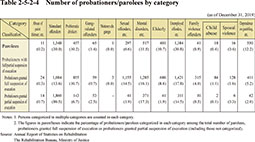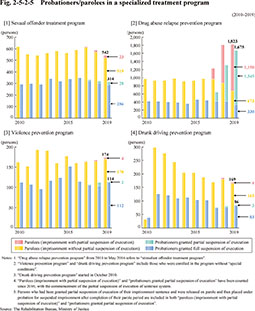2 Treatment during probation/parole
The treatment of persons under probation/parole supervision is mainly based on graduated treatment and treatment in accordance with their problems, such as categorized treatment, in order to prevent their re-offending and facilitate their reformation and rehabilitation.
(1) Graduated treatment
Graduated treatment is a system that classifies persons under probation/parole supervision into one of four different treatment levels according to their progress in reformation and rehabilitation, their risk of re-offending, and their necessity for guidance and assistance, etc. In accordance with the level they belong to, differing levels of involvement and frequency of contact by probation officers are provided.
Parolees sentenced to life imprisonment and long-term imprisonment (refers to imprisonment for 10 years or more) face various difficulties in reintegrating themselves back into society and hence are classified into the highest level for the first year after their release. And they are provided with more substantial treatment involving multiple probation officers, if necessary.
(2) Treatment in accordance with problems
Categorized treatment means to categorize problems and other characteristics of persons under probation/parole supervision according to their offenses/delinquency. And it aims to efficiently treat them by focusing on those problems so as to provide effective probation/parole supervision.
Table 2-5-2-4 shows the number of probationers/parolees by category in 2019.
Table 2-5-2-4 Number of probationers/parolees by category
Persons under probation/parole supervision who have specific criminal tendencies are provided in a systemized manner, as a part of instruction and supervision, with specialized treatment programs, which are built upon psychological and other expertise with cognitive behavioral therapy as a base theory.
Fig. 2-5-2-5 shows the trend in the number of probationers/parolees who participated in specialized treatment programs.
Fig. 2-5-2-5 Probationers/parolees in a specialized treatment program

